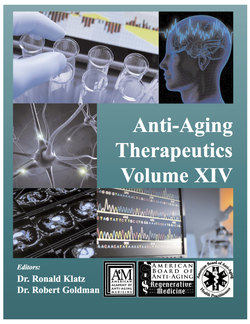Читать книгу Anti-Aging Therapeutics Volume XIV - A4M American Academy - Страница 25
На сайте Литреса книга снята с продажи.
NITRIC OXIDE DIAGNOSTICS
ОглавлениеNow that we have recognized and proven ways to restore NO in humans, how does one recognize NO insufficiency before the manifestation of disease? This is a critically important issue if we want to prevent disease. Understanding the normal metabolism of NO allows us to develop novel diagnostics. The major pathway for NO metabolism is the stepwise oxidation to nitrite and nitrate. For years, both nitrite (NO2-) and nitrate (NO3-) (collectively, NOx) have been used as surrogate markers of NO production in biological tissues, but there have not been any new developments in the use of NO biomarkers in the clinical setting for diagnostic or prognostic utility. In fact, NO status is still not part of the standard blood chemistry routinely used for diagnostic purposes. This is simply unacceptable given the critical nature of NO in many disease processes, thus new technologies should be developed.43 The only true measure of endothelial NO production (endothelial function) is through flow mediated dilatation (FMD). FMD is a non-invasive ultrasound-based method where arterial diameter is measured in response to an increase in shear stress, which causes release of NO from the endothelium and consequent endothelium dependent dilatation. FMD has been shown to correlate with invasive measures of endothelial function, as well as with the presence and severity of the major traditional vascular risk factors.44 NOx have recently been shown to be biomarkers for cardiovascular and other diseases from both diagnostic and therapeutic aspects.45 However, it is not known if levels of nitrite and nitrate correlate with FMD. In addition to blood, urinary levels of NOx provide a means to assess systemic NO production in vivo, or renal handling of these anions, which may be compromised in the geriatric patient.46 A report by Kleinbongard et al47 demonstrated that plasma nitrite levels in humans progressively decrease with increasing cardiovascular risk load. Risk factors considered included age, hypertension, smoking, and hypercholesterolemia, conditions all known to reduce the bioavailability of NO. Although a correlation exists in the plasma, it is not known whether the situation is mirrored in the heart or other tissue of interest in specific disease. The recent recognition of a human nitrogen cycle whereby nitrate and nitrite are reduced to NO by an enterosalivary circulation of nitrate13 opens up the potential for using saliva as a potential biomarker for NO status in certain diseases. These novel NO diagnostic test strips are now commercially available through Neogenis Labs (www.neogenis.com).
NATURAL PRODUCT CHEMISTRY FROM PLANTS GENERATE NITRIC OXIDE
Traditional herbal medicines used for thousands of years in Asia and other regions have been proven effective in certain cardiovascular disorders. Some of the herbal medicines have profound NO bioactivity primarily due to the nitrate-nitrite-NO reduction pathway, as they contain very large amounts of NOx in the extracts given to patients.32 The described benefits of these ancient medications may be attributed to their inherent NOx content combined with their robust NOx reductase activity to generate NO independent of the L-arginine-NO pathway.14,26,32,50 The therapeutic benefits of these herbal medicines are providing an alternative source of NO to patients that may be unable to make NO from L-arginine owing to endothelial dysfunction.
There is an endogenous nitrite reductase activity in animal tissues, such as the liver and aorta, but this inherent biological capacity is low (around 1 pmol/mg protein). The reductase activity in some of these herbal medicines may exceed that detected in the animal tissues.32 It is estimated that the increased reductase activity may occur by orders of magnitude, almost 1000-times higher than endogenous production of NO. This would equate to 300 nmoles per day of NO from a single herbal preparation. The average NO production in the human body (70 kg) is 1.68 mmol NO per day (based on an NO production rate of 1 μmol/kg/h). By supplying the exogenous NOx and reductase activities, herbal medicines offer an alternative therapeutic strategy to combat or treat any condition related to NO insufficiency including heart disease and hypertension.
Maintaining NO homeostasis requires the repletion of NOx through which the ability to generate NO can be restored to compensate for the inability of the endothelium to convert L-arginine to NO in coronary heart disease. This concept has recently been tested through the development of a rationally designed dietary supplement with natural products selected for their NO activity based on their NOx content as well as an oxygen independent nitrite reductase. In a double-blinded, placebo-controlled study in patients over the age of 40 with at least 3 cardiovascular risk factors, this type of technology was found to significantly restore plasma levels of NOx, reduce triglycerides by 27%, and modestly reduce blood pressure and C-reactive protein thereby modifying the cardiovascular risk profile of patients after only 30 days.36 Harnessing the NO activity of natural plant-based products may provide a first line of defense for conditions associated with NO insufficiency.
